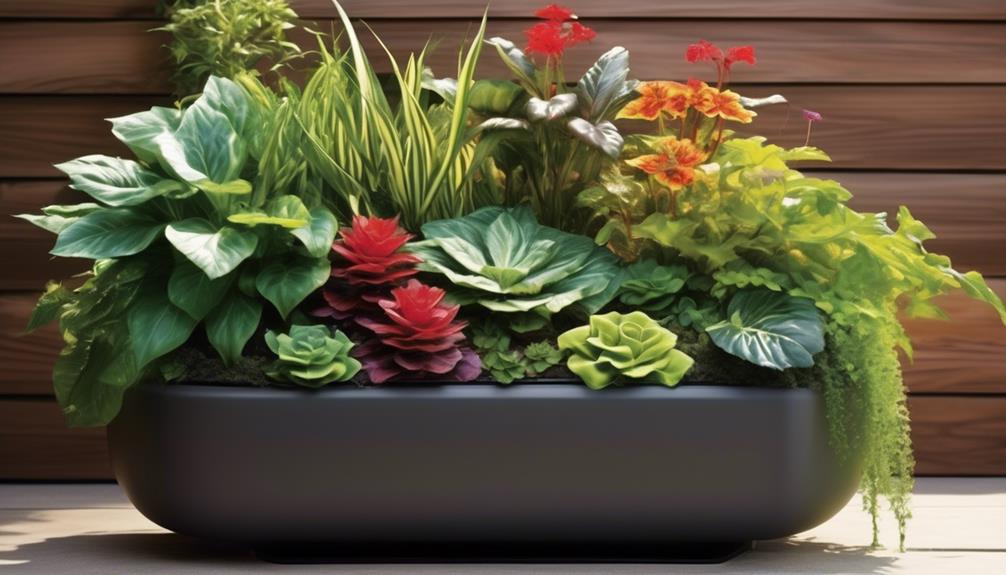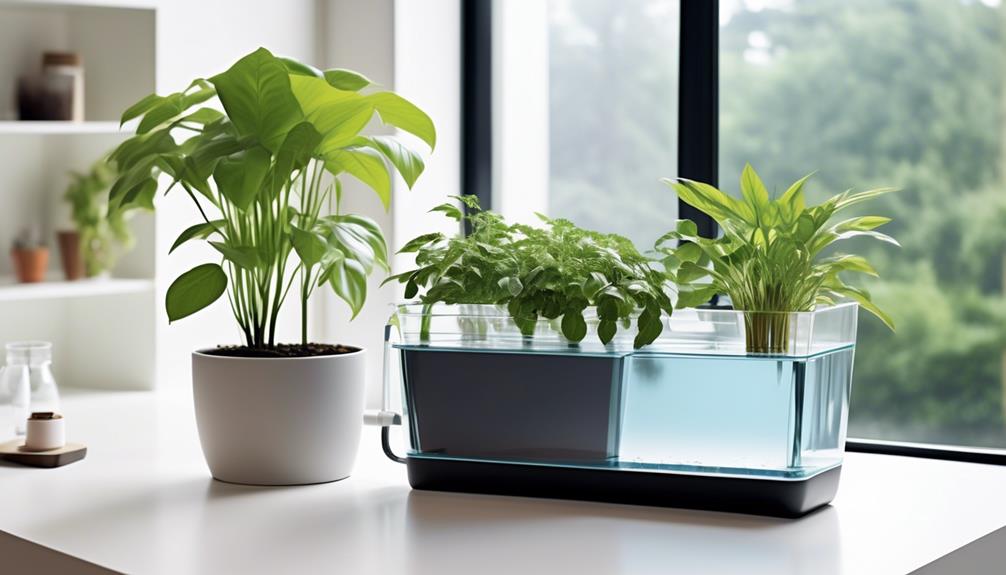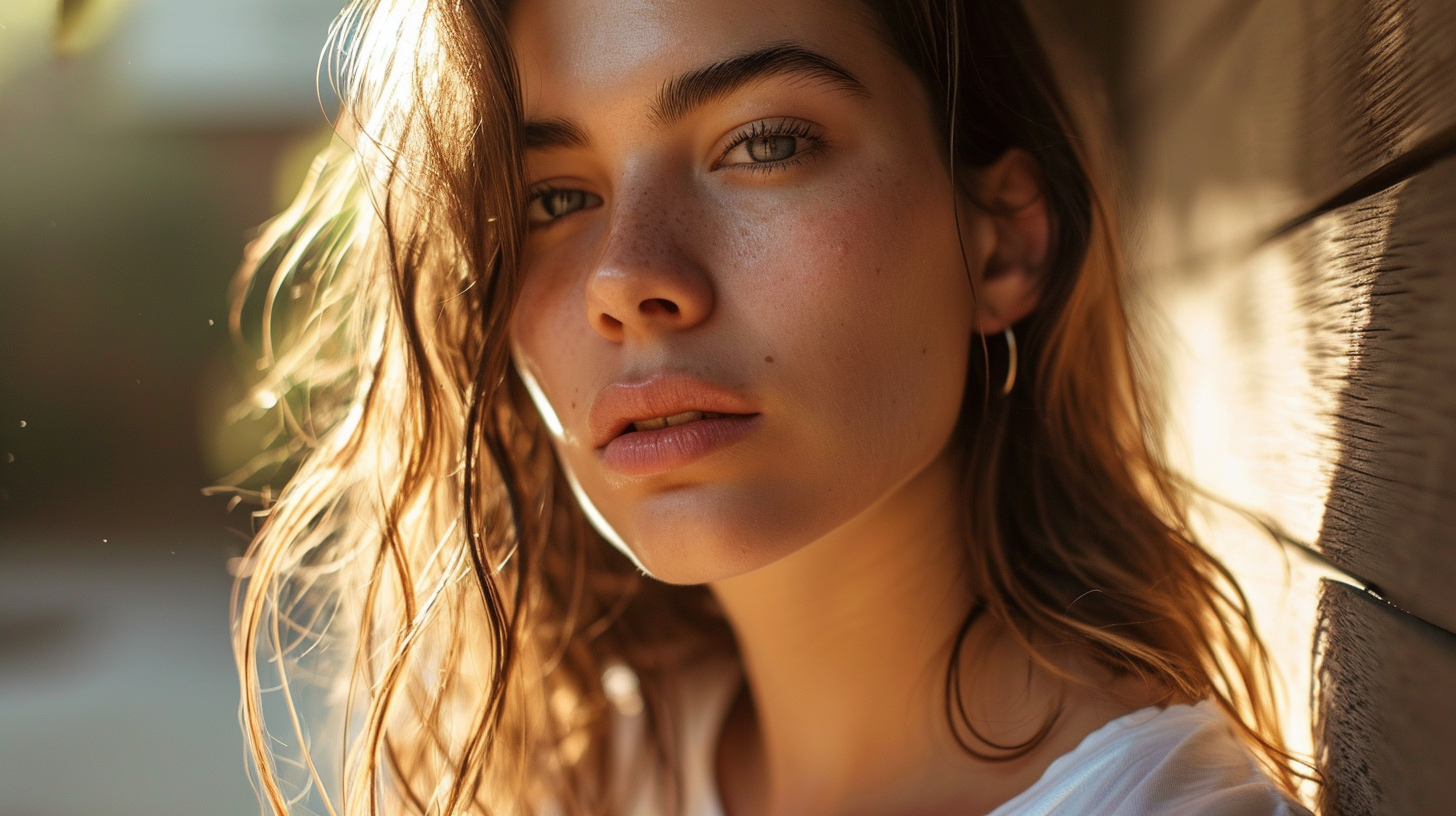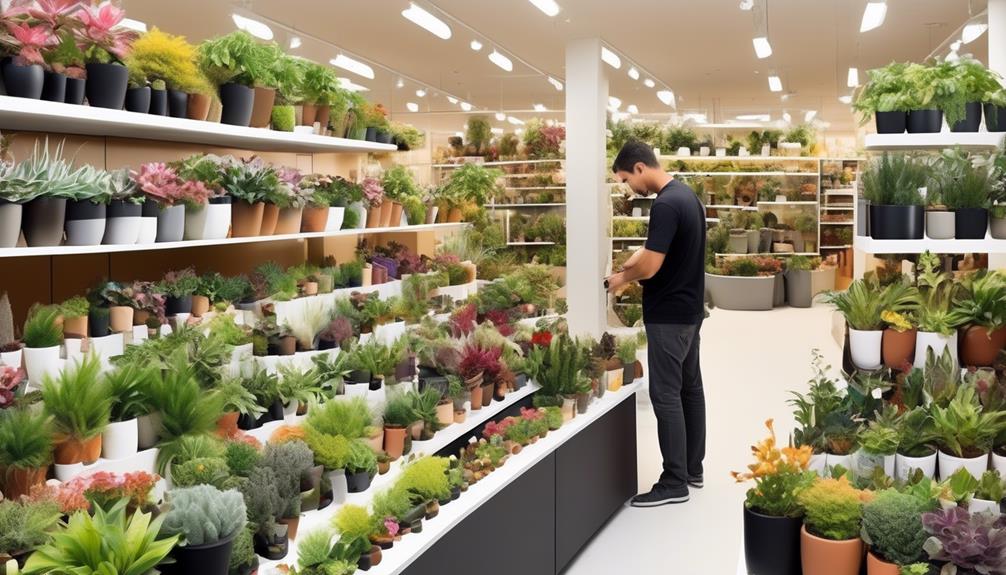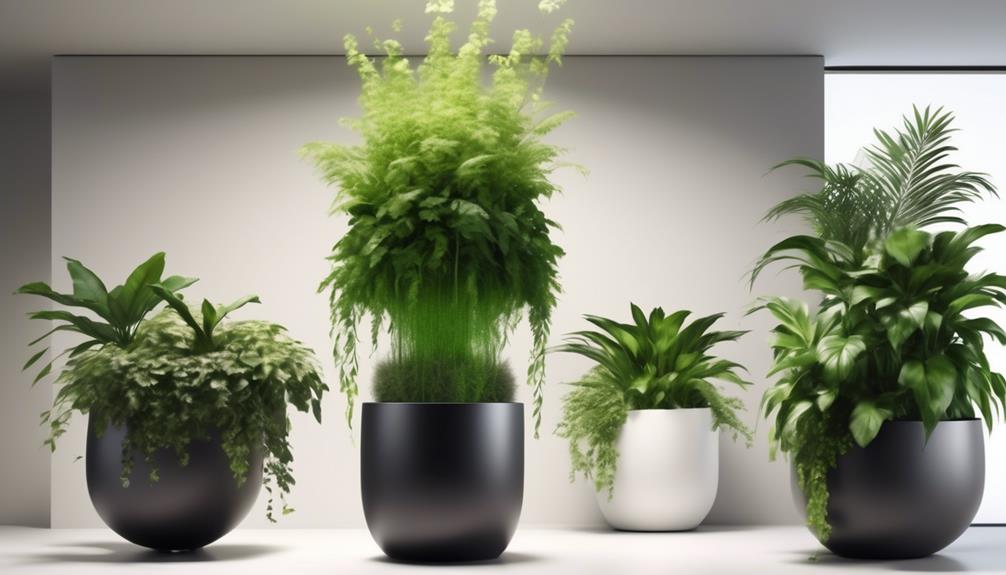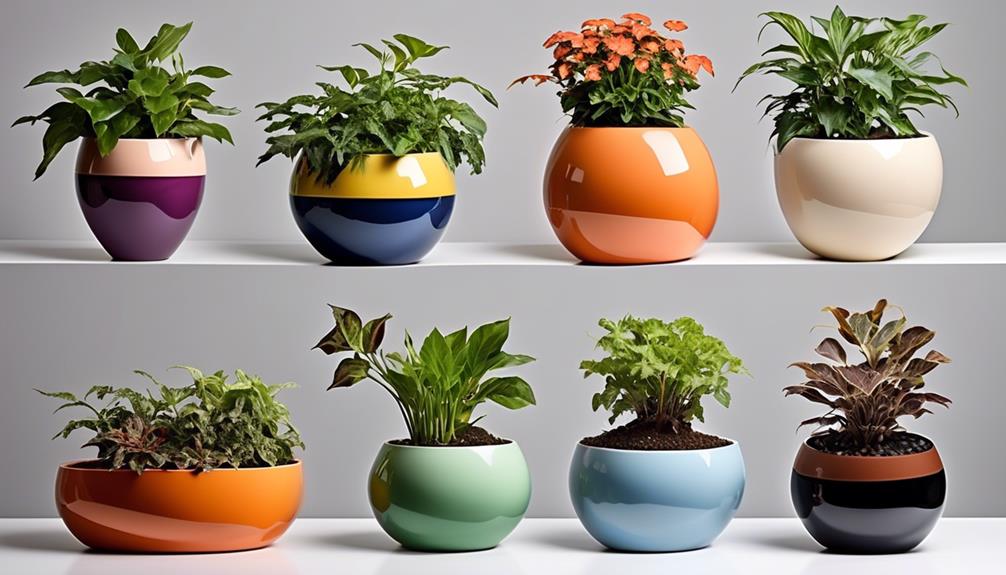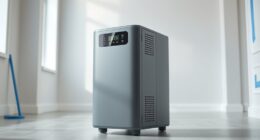Exploring the world of self-watering planters can seem like venturing into uncharted territory. These innovative containers come with promising claims, but there is a natural curiosity about whether they can truly deliver on their advertised benefits.
We've all heard the hype, but let's take a closer look at the science and practicality behind these self-sufficient containers. Does the concept hold water, or are we left high and dry?
Let's unravel the truth behind the effectiveness of self-watering planters and separate fact from fiction.
Key Takeaways
- Self-watering planters utilize a reservoir system and capillary action to provide water to plants.
- They prevent over-watering and under-watering, promoting optimal plant health.
- Self-watering planters provide consistent moisture levels and enhance nutrient uptake for healthier plant growth.
- However, there is a potential for overwatering if not properly designed or maintained, and they may not be suitable for all plant species.
Understanding Self-Watering Planters
Self-watering planters utilize a reservoir system that actively provides water to the plant, maintaining a consistent level of moisture in the soil. This mechanism enhances watering efficiency by ensuring that the plant receives water as needed, promoting optimal plant health. The reservoir system works through capillary action, where the plant roots draw water from the reservoir into the soil. This process mimics natural groundwater movement, allowing the plant to uptake water as per its requirements, leading to improved water conservation.
By maintaining a steady moisture level in the soil, self-watering planters create an environment that's conducive to plant growth. This consistency in moisture levels helps in preventing both over-watering and under-watering, common issues in traditional watering methods. As a result, the plants are better equipped to withstand environmental stresses, leading to improved overall plant health.
The environmental benefits of self-watering planters are significant. By promoting water conservation through efficient usage, these planters are environmentally friendly. They reduce water wastage often associated with conventional watering methods, making them a sustainable choice for plant cultivation.
How Self-Watering Planters Function
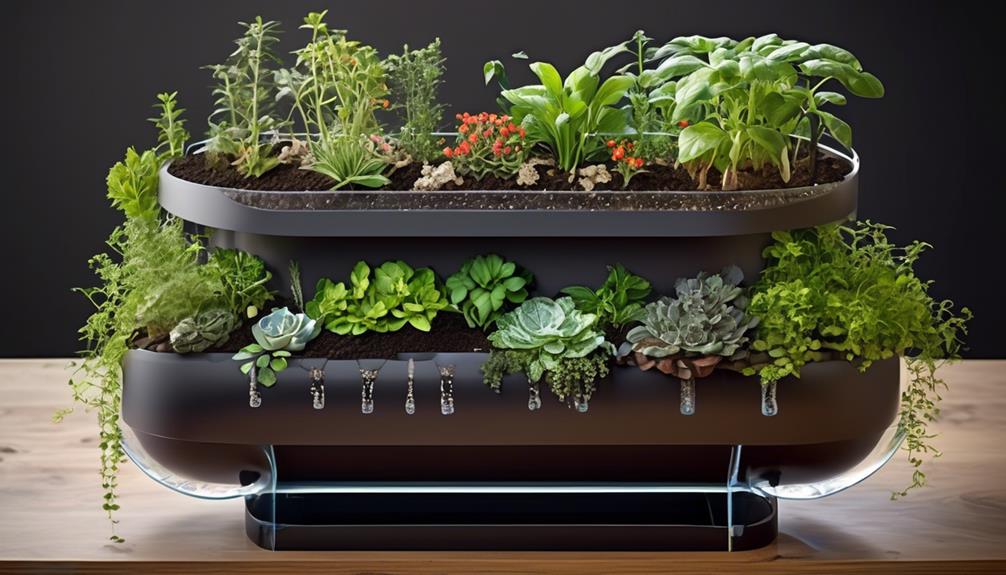
Utilizing a built-in reservoir system and capillary action, self-watering planters function by providing a consistent and efficient water supply to the plant, mimicking natural groundwater movement to promote optimal plant health.
The mechanics of self-watering planters involve a two-part system: the reservoir and the soil. The reservoir, typically located at the bottom of the planter, holds water. A wicking mechanism, often a fabric strip or soil with high water retention, extends from the reservoir into the soil. Through capillary action, water is drawn up from the reservoir and into the soil as needed, ensuring that the plant roots have access to water at all times.
This water absorption technology allows the plant to take up water as required, reducing the risk of overwatering or underwatering. Additionally, some self-watering planters incorporate a water level indicator, allowing the user to monitor the water level in the reservoir easily.
Benefits of Self-Watering Planters
We can observe several significant benefits associated with the use of self-watering planters in promoting plant health and simplifying the task of plant care.
- Consistent Moisture Levels: Self-watering planters provide a consistent moisture level to the plants, ensuring they receive an adequate water supply. This is particularly beneficial for busy individuals or frequent travelers who may not be able to water their plants regularly.
- Prevention of Overwatering: These planters prevent overwatering, a common issue that can lead to root rot and other plant diseases. The self-watering system allows the plant to draw up moisture as needed, reducing the risk of waterlogging the soil.
- Enhanced Nutrient Uptake: The design of self-watering planters promotes optimal nutrient uptake by the plants, as the roots can access water and nutrients as required. This can lead to healthier, more vibrant plant growth.
Drawbacks of Self-Watering Planters
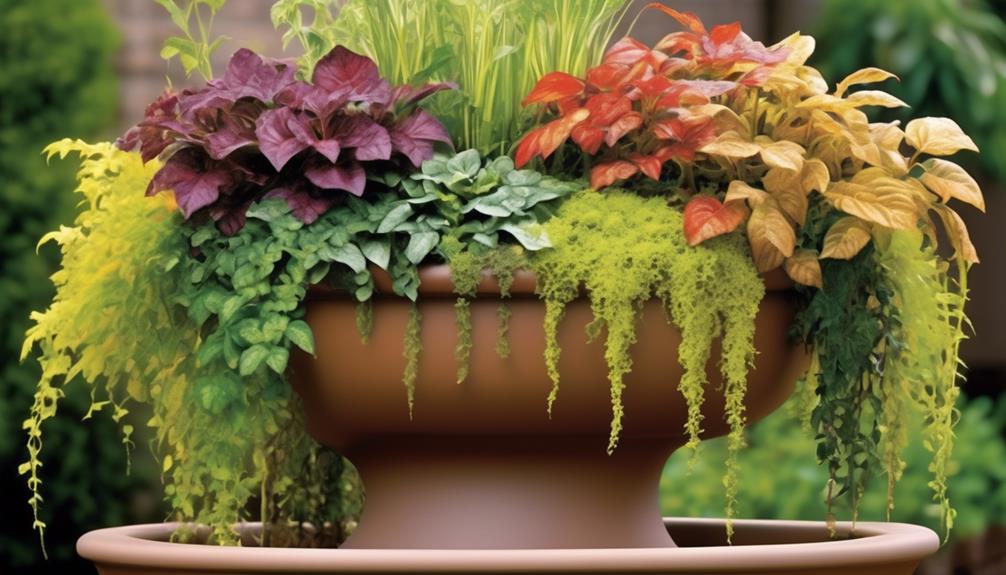
Despite their potential advantages, self-watering planters have certain drawbacks that should be carefully considered before choosing them for plant care. One of the main drawbacks is the potential for overwatering. While the self-watering system is designed to provide plants with the right amount of water, there is still a risk of waterlogging if the planter is not properly designed or maintained. Additionally, some plants may have specific watering needs that cannot be met by a self-watering planter, leading to issues with plant health and growth. Another drawback is the initial cost, as self-watering planters can be more expensive than traditional planters. Moreover, maintenance challenges can arise with self-watering planters, as they require periodic cleaning to prevent algae growth and clogging of the watering system.
| Drawbacks of Self-Watering Planters |
|---|
| Potential for overwatering |
| Specific plant watering needs |
| Initial cost |
| Maintenance challenges |
| Limited suitability for all plants |
Choosing the Right Self-Watering Planter
The selection of an appropriate self-watering planter is crucial for ensuring optimal plant health and growth. When choosing the right self-watering planter, several key factors need to be considered to provide the best environment for plant growth.
- Choosing Planter Size: Selecting the correct planter size is essential for the well-being of your plants. A planter that's too small may restrict root growth, while a planter that's too large can lead to overwatering and root rot. It's important to choose a planter that accommodates the specific needs of the plant, considering its mature size and root system.
- Watering Frequency Suggestions: Different plants have varying watering needs. When selecting a self-watering planter, it's crucial to consider the watering requirements of the specific plant species you intend to grow. Some plants may require more frequent watering, while others may prefer drier conditions. Understanding the watering needs of your plants will help in choosing a self-watering planter that can cater to those requirements effectively.
- Drainage and Aeration: Proper drainage and aeration are important factors to consider when choosing a self-watering planter. The planter should have adequate drainage to prevent waterlogging, which can lead to root rot. Additionally, good aeration is essential for healthy root development and overall plant growth.
Selecting the right self-watering planter involves careful consideration of these factors to provide the best growing conditions for your plants.
Setting Up Self-Watering Planters
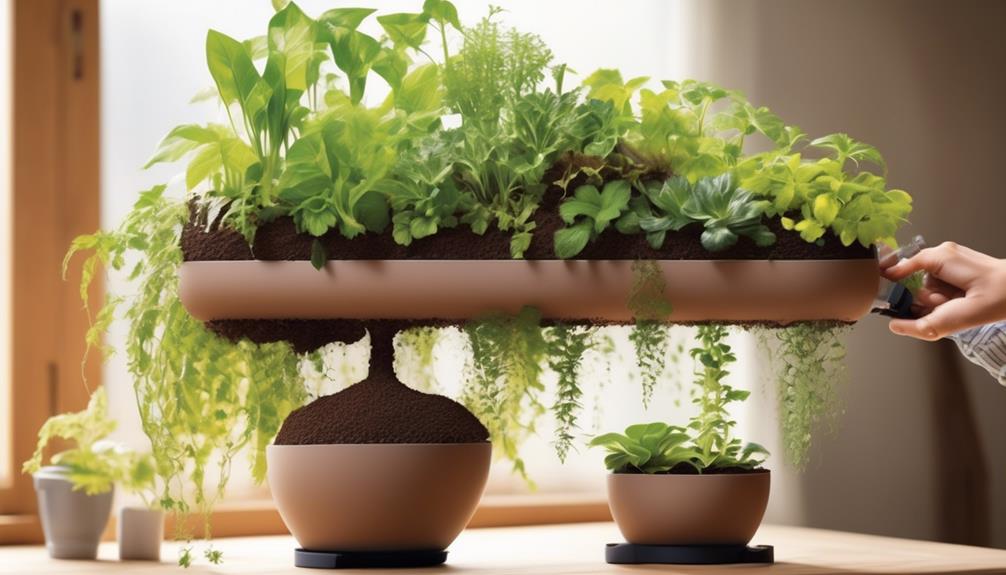
Setting up self-watering planters involves carefully assembling the components to ensure efficient water distribution and proper plant hydration.
When setting up a self-watering planter, consider the watering frequency and the planter size to ensure optimal plant growth. Begin by choosing a planter size that matches the needs of your plant and the space available. Larger planters can hold more water and accommodate larger plants, while smaller ones are suitable for compact spaces and small plants.
Once the planter size is determined, assemble the self-watering system, ensuring that the wicking mechanism is properly installed to draw water from the reservoir to the soil. Adjust the watering frequency based on the plant's specific needs and environmental conditions. It's essential to monitor the moisture levels initially to determine the ideal watering frequency.
Watering Techniques for Self-Watering Planters
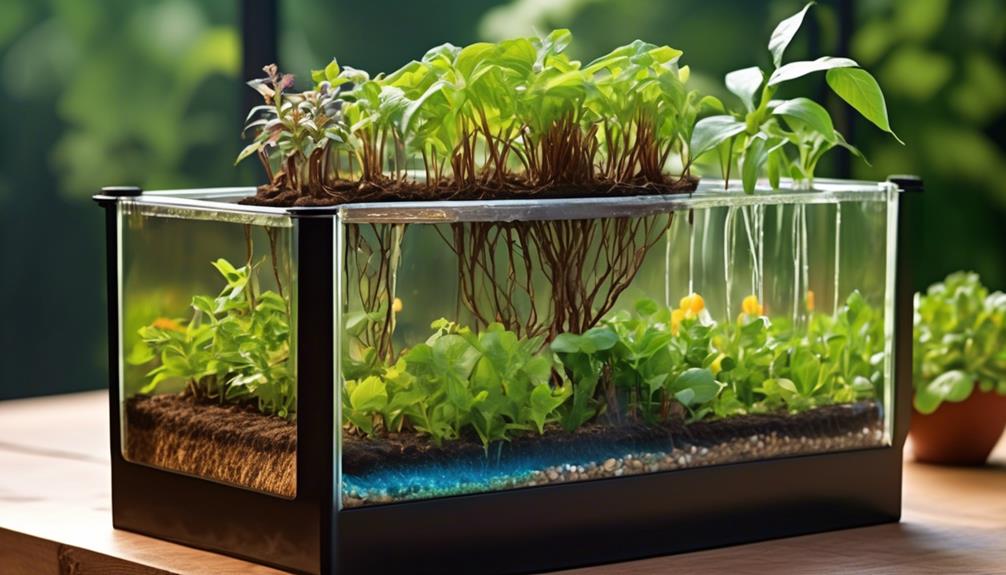
When assembling the self-watering system for planters, it's essential to consider the appropriate watering techniques to ensure optimal moisture distribution and plant health. Efficient watering plays a crucial role in maintaining proper plant hydration and moisture levels, ultimately influencing plant growth and overall well-being.
Here are three key techniques to consider:
- Capillary Action: Utilizing capillary wicks or mats can facilitate water movement from the reservoir to the soil, ensuring consistent moisture supply to the plant roots.
- Monitoring Water Levels: Regularly checking the water levels in the reservoir helps in preventing overwatering or underwatering, thus maintaining the ideal moisture balance for the plants.
- Adjusting Watering Frequency: Understanding the specific water needs of different plant species is vital for adjusting the watering frequency, ensuring that each plant receives the right amount of water for optimal growth and development.
Best Plants for Self-Watering Planters

When selecting plants for self-watering planters, it's crucial to consider their water needs and growth habits. Certain plants, such as ferns and peace lilies, thrive in consistently moist soil and are well-suited for self-watering systems.
We'll also explore how different watering systems, such as wicking and reservoir-based, can impact the growth and health of various plant types.
Ideal Plant Choices
Selecting the most suitable plants for self-watering planters is crucial for ensuring their effective and successful growth within this innovative irrigation system. When choosing plants for self-watering planters, it's important to consider their water requirements, root size, and growth habits.
Here are some ideal plant choices for self-watering planters:
- Herbs like basil, mint, and cilantro thrive in self-watering planters, providing a fresh and aromatic addition to your culinary endeavors.
- Succulents such as echeveria, sedum, and aloe vera are well-suited for self-watering planters, adding a touch of natural beauty to any space without requiring frequent watering.
- Compact vegetables like cherry tomatoes, peppers, and lettuce are excellent choices for self-watering planters, allowing for a convenient and sustainable homegrown produce.
Watering System Effectiveness
Considering the water requirements, root size, and growth habits of plants is crucial in determining the effectiveness of the watering system in self-watering planters. The watering frequency and water retention capacity of different plant species greatly influence the overall efficiency of the self-watering system. To illustrate, plants with high water requirements or extensive root systems may not thrive as effectively in self-watering planters with limited water retention capabilities. Below is a table highlighting the water requirements and suitability of various plants for self-watering planters:
| Plant Type | Water Requirements | Suitability |
|---|---|---|
| Succulents | Low | Highly Suitable |
| Herbs | Moderate | Suitable |
| Leafy Greens | High | Less Suitable |
Understanding the water needs and root behaviors of different plants is essential in maximizing the effectiveness of self-watering systems.
Maintaining Self-Watering Planters
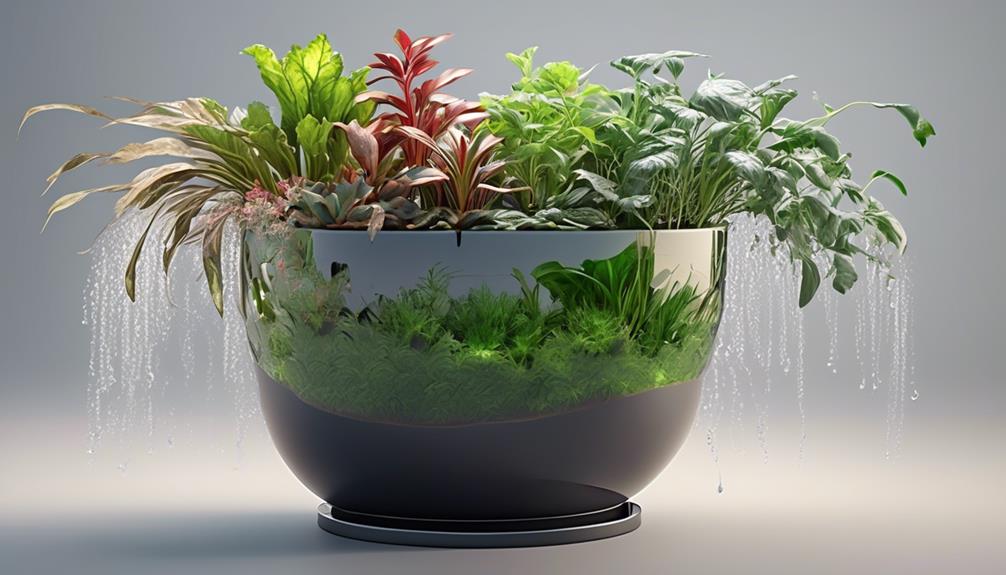
To maintain self-watering planters effectively, it's crucial to regularly monitor the water level and condition of the soil to ensure optimal growth conditions for the plants. Proper maintenance is essential for the success of self-watering planters, and the following steps can help achieve this:
- Regular Water Level Checks: Ensuring that the reservoir of the self-watering planter has an adequate supply of water is essential for the well-being of the plants. Regularly checking the water level and refilling it as necessary is vital to prevent the plants from drying out.
- Soil Moisture Monitoring: Monitoring the moisture level of the soil is crucial to prevent overwatering or underwatering. This can be achieved by physically checking the soil or by using moisture meters to accurately gauge the moisture content.
- Cleaning and Maintenance of Watering System Components: Periodically cleaning the watering system components, such as the wick or the water distribution system, is important to prevent clogging and ensure the proper functioning of the self-watering planter.
Troubleshooting Self-Watering Planters

When troubleshooting self-watering planters, it's important to assess the efficiency of the watering system and monitor soil moisture levels.
We can troubleshoot the watering system by checking for clogs, leaks, or malfunctions in the delivery mechanism.
Additionally, monitoring soil moisture can help identify any issues with water distribution and root health.
Watering System Efficiency
We observed that the self-watering system's efficiency in certain planters was affected by the soil type and the rate of water absorption by the plants. Understanding the watering frequency and effectiveness is crucial for maintaining optimal soil moisture and plant health.
Factors influencing the watering system's efficiency include:
- Soil composition: Different soil types can impact the distribution and retention of water, affecting the self-watering system's performance.
- Plant species: Variations in the rate of water absorption among different plant species may influence the effectiveness of the self-watering system.
- Environmental conditions: Temperature and humidity levels can affect the evaporation rate of water from the soil, influencing the overall efficiency of the self-watering system.
These considerations are essential for ensuring the proper functioning of self-watering planters and promoting healthy plant growth.
Soil Moisture Monitoring
Monitoring soil moisture levels is critical in troubleshooting self-watering planters, as it directly impacts the efficiency of the watering system, influenced by factors such as soil composition, plant species, and environmental conditions. Accurately assessing soil moisture levels is essential for ensuring optimal plant growth and preventing issues such as overwatering or underwatering. The table below provides an overview of common methods for monitoring soil moisture and their advantages.
| Soil Moisture Monitoring Method | Description | Advantages |
|---|---|---|
| Tensiometers | Measure soil tension to indicate moisture levels | Precise and direct measurement of plant-available water |
| Electrical Conductivity Meters | Assess soil moisture by measuring electrical conductivity | Provides quick and accurate readings |
| Time Domain Reflectometry | Uses electromagnetic waves to determine soil moisture | Suitable for continuous monitoring and various soil types |
Effective soil moisture monitoring allows for timely adjustments to the self-watering system, promoting optimal plant health and growth.
In this section, we have discussed the importance of monitoring soil moisture levels in troubleshooting self-watering planters. By understanding the various methods for assessing soil moisture, gardeners can ensure that their plants receive the appropriate amount of water for healthy growth.
Self-Watering Planters for Indoor Use
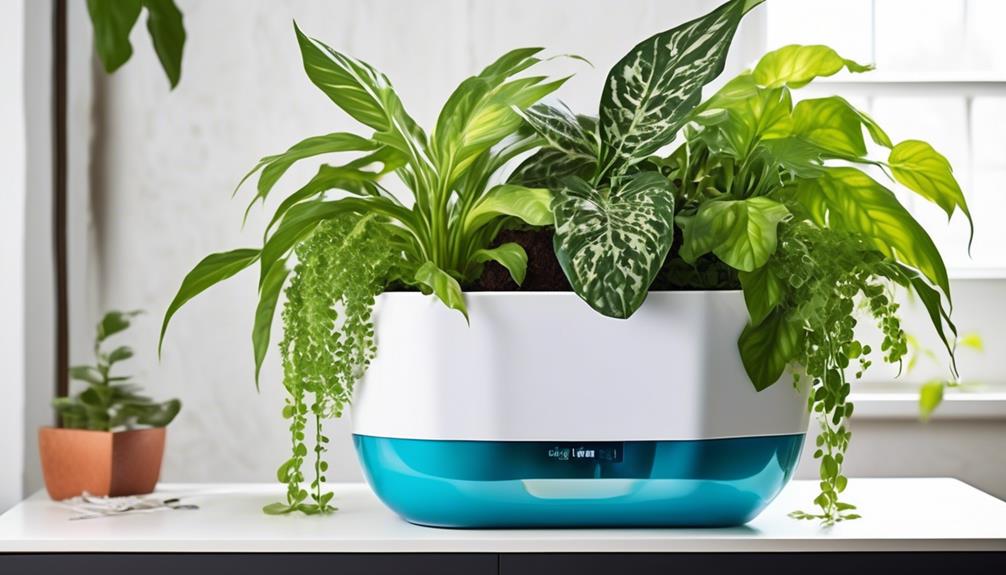
Using a self-watering planter for indoor plants can provide consistent moisture levels and reduce the frequency of manual watering. These planters are designed to maintain optimal plant hydration levels, making them suitable for indoor gardening.
Here are a few reasons why self-watering planters can be beneficial for indoor use:
- Effortless Maintenance: Self-watering planters reduce the need for frequent watering, making it easier to maintain indoor plants without the hassle of regular manual watering.
- Consistent Moisture: These planters ensure that indoor plants receive a consistent level of moisture, promoting healthy growth and reducing the risk of over or under-watering.
- Peace of Mind: With self-watering planters, there's a sense of assurance that the plants are being consistently hydrated, even when away from home, providing peace of mind to individuals who may not always be available to water their plants.
Self-Watering Planters for Outdoor Use

When considering self-watering planters for outdoor use, it's important to understand the unique challenges of outdoor plant watering. Factors such as varying weather conditions, sunlight exposure, and soil drainage play a significant role in the success of outdoor planters.
Outdoor Plant Watering
Self-watering planters for outdoor use provide a consistent and efficient method for delivering water to plants without the need for frequent manual watering. These planters offer several benefits:
- Reduced Maintenance: Self-watering planters decrease the frequency of watering, reducing the time and effort required for outdoor plant maintenance.
- Water Conservation: By providing water directly to the plant's roots, these planters minimize water wastage through evaporation or runoff, promoting sustainable outdoor plant care.
- Plant Health: The consistent moisture levels maintained by self-watering planters support optimal plant growth and health, reducing the risk of over or under-watering.
Self-Watering Planter Benefits
With the reduced maintenance and water conservation benefits of self-watering planters for outdoor use established, it is important to analyze their impact on plant health and overall growth. Self-watering planters offer several benefits, including improved plant health, consistent moisture levels, and reduced water consumption. However, there are some drawbacks to consider, such as the initial cost of the planter and the potential for overwatering if not used properly. In terms of effectiveness, self-watering planters efficiently deliver water to the plants' roots, promoting healthy growth. The efficiency of self-watering planters lies in their ability to minimize water wastage through evaporation and runoff. Overall, the benefits of using self-watering planters for outdoor plants outweigh the drawbacks, making them a valuable tool for maintaining healthy and thriving gardens.
| Benefits | Drawbacks |
|---|---|
| Improved plant health | Initial cost |
| Consistent moisture levels | Potential for overwatering |
| Reduced water consumption | – |
Comparing Self-Watering Planters to Traditional Planters
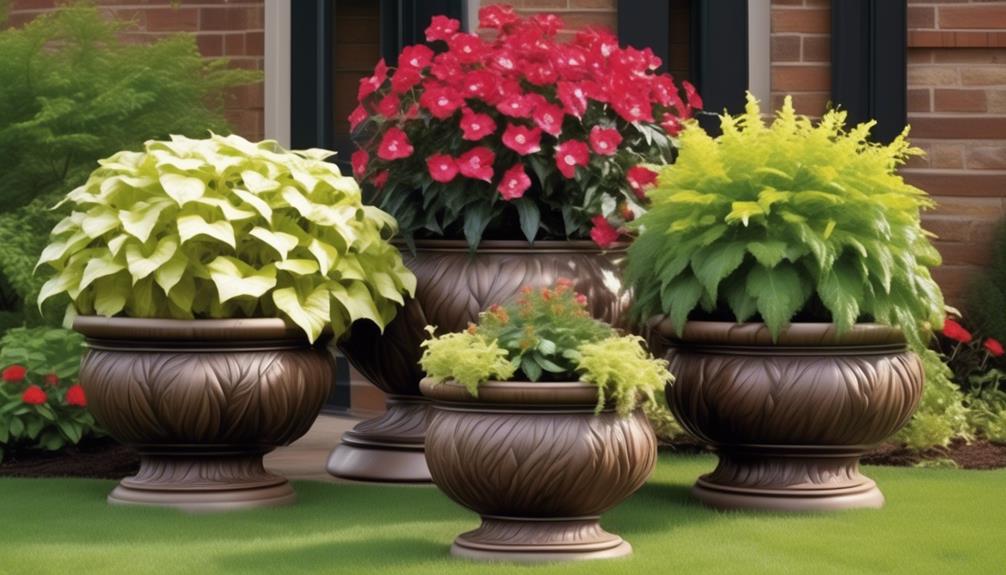
In comparing self-watering planters to traditional planters, we've observed a significant difference in the efficiency of water management and plant health.
Self-watering planters, with their built-in reservoirs, provide a more efficient way of watering plants by delivering water directly to the roots as needed, reducing water wastage and the frequency of watering. This results in improved plant health and growth due to consistent moisture levels and reduced risk of overwatering.
Self-watering planters promote healthier root systems by providing a more controlled and consistent water supply, leading to lusher foliage and better fruit production.
Traditional planters often lead to uneven moisture distribution, making it challenging to maintain optimal soil moisture levels, which can result in root rot and stunted growth.
The convenience of self-watering planters allows for worry-free vacations and extended time between watering, reducing the stress of plant care and enhancing the overall gardening experience.
These differences underline the advantage of self-watering planters in terms of watering efficiency and plant care, making them a compelling choice for any plant enthusiast seeking to optimize their gardening efforts.
DIY Self-Watering Planter Options
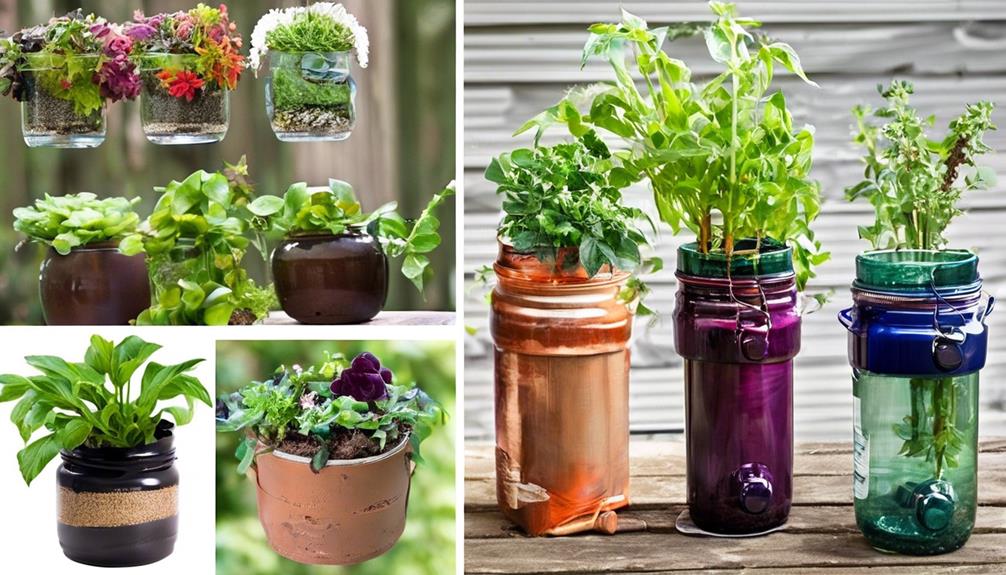
When considering DIY self-watering planter options, it's important to understand the materials needed, the step-by-step process, and the potential benefits.
We'll discuss the specific materials required for constructing a self-watering planter, detailing the process involved in creating one, and examining the advantages of choosing a DIY approach.
DIY Materials Needed
To create a DIY self-watering planter, one can gather the necessary materials such as a plastic container, a wicking material like cotton or felt, a water reservoir, and potting mix. When considering DIY planter design, the following materials are essential for creating a self-watering container:
- Plastic Container: Ensure it's large enough to accommodate the plant and has a lid to act as a water reservoir.
- Wicking Material: Use cotton or felt to draw water from the reservoir to the potting mix, ensuring consistent moisture for the plant.
- Water Reservoir: This is crucial for storing the water that will be wicked up to the plant's roots, maintaining the soil's moisture levels.
These materials are vital for constructing an effective self-watering planter, promoting healthy plant growth and reducing the need for frequent watering.
Step-by-Step Guide
Considering the necessary materials, constructing a self-watering planter involves a step-by-step process to ensure its functionality and effectiveness in providing consistent moisture to the plant.
First, select a suitable container with a false bottom and drainage holes.
Next, place a wick, such as a piece of cotton rope, through the drainage hole to draw water into the soil.
Then, add a layer of landscape fabric to separate the soil from the water reservoir.
Afterward, fill the bottom of the container with water-absorbing material like perlite or vermiculite.
Following this, add soil to the planter and place the potted plant on top.
Finally, periodically refill the water reservoir to maintain plant hydration and watering efficiency.
This step-by-step process ensures a well-designed self-watering planter for optimal plant growth.
Benefits of DIY
After constructing a well-designed self-watering planter using the step-by-step guide, we can now explore the benefits of DIY self-watering planter options, which offer practical and efficient solutions for maintaining plant hydration.
- Customization: DIY planter designs allow us to customize the size, shape, and materials to suit our specific needs and preferences, providing a sense of ownership and pride in our creation.
- Cost-Effectiveness: Building our own self-watering planters can be more cost-effective than purchasing pre-made ones, saving money in the long run and allowing for investment in higher quality materials.
- Environmental Impact: Embracing DIY self-watering planter options aligns with the benefits of sustainability, reducing carbon footprint by utilizing recycled or repurposed materials and promoting eco-friendly gardening practices.
Maximizing Success With Self-Watering Planters
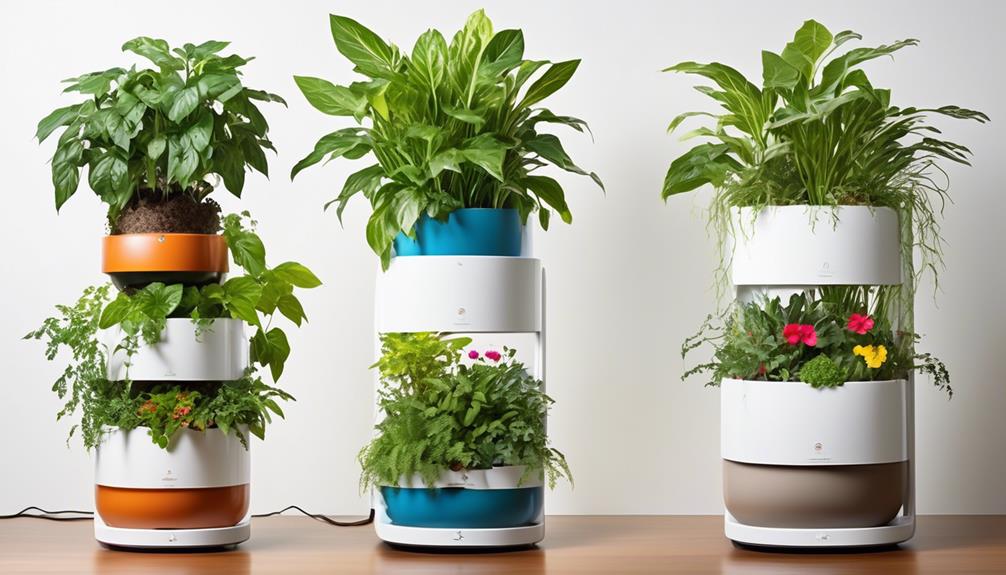
In order to achieve optimal results with self-watering planters, it is crucial to carefully monitor the moisture levels and adjust the watering frequency as needed. This ensures that the plants receive the right amount of water, preventing both underwatering and overwatering. When using self-watering planters, mastering the watering frequency is key to successful container gardening techniques. Here, we provide a guide to help you maximize the potential of your self-watering planters:
| Moisture Level | Action |
|---|---|
| Dry | Refill the reservoir |
| Adequate | Monitor closely |
| Excess | Remove excess water |
Frequently Asked Questions
Can Self-Watering Planters Be Used for All Types of Plants, or Are There Specific Plants That Work Best With This System?
Self-watering planters can be used for a variety of plants, but some are better suited than others. Best plants for self-watering systems include herbs, vegetables, and small ornamental plants. These systems work well with plants that prefer consistently moist soil. However, plants that thrive in dry conditions may not be compatible.
It's important to consider the watering needs of specific plants and alternative watering methods before using self-watering planters.
Are Self-Watering Planters Suitable for Use in Extreme Weather Conditions, Such as Intense Heat or Cold Temperatures?
In extreme weather conditions, such as intense heat or cold temperatures, self-watering planters have shown effectiveness and efficiency in maintaining proper moisture levels for plants. They're designed to provide consistent hydration, ensuring the plants' survival.
The durability and low maintenance of self-watering planters make them suitable for use in such conditions, as they can withstand harsh weather and require minimal attention, making them a reliable option for all types of plants.
How Long Do the Self-Watering Mechanisms Typically Last Before Needing to Be Replaced or Repaired?
The self-watering mechanisms typically last several years before needing repair or replacement. Pros include consistent moisture levels and reduced watering frequency. Cons may involve clogs or malfunctions.
Maintenance tips include regular cleaning and checking for blockages.
Plant compatibility varies, with some thriving and others needing traditional watering methods.
Extreme weather performance is generally good, though extreme heat can impact water evaporation.
Repair and replacement cycles depend on usage and care.
Can Self-Watering Planters Be Used in Conjunction With Traditional Watering Methods, or Is It Best to Solely Rely on the Self-Watering Feature?
Like a skilled gardener tending to their plants, we've found that combining self-watering planters with traditional watering methods can be beneficial.
While the self-watering feature provides consistent hydration, manual watering allows for a more tailored approach.
This combination can promote optimal plant health and growth. However, solely relying on the self-watering feature may lead to over or under watering, impacting watering efficiency and plant vitality.
Are There Any Specific Maintenance Tasks or Precautions That Need to Be Taken With Self-Watering Planters to Ensure Their Long-Term Effectiveness?
Maintenance tips for self-watering planters include:
- Regularly checking water levels
- Cleaning the watering system
- Monitoring for clogs
Precautionary measures involve:
- Using appropriate soil
- Ensuring proper drainage to prevent root rot
Additionally, periodic inspection of the planter's components and adjusting the watering system based on environmental conditions is essential for long-term effectiveness.
These steps optimize the planter's performance and support healthy plant growth.
Are Self Watering Planters Effective in Keeping Plants Hydrated?
Yes, self watering planters effectiveness has been proven in keeping plants hydrated. These innovative planters provide a consistent supply of water to the plants, preventing over or under watering. They are especially beneficial for busy individuals or those who tend to forget to water their plants regularly.
Conclusion
In conclusion, self-watering planters are an effective and efficient way to maintain healthy plants with minimal effort. They work by utilizing a reservoir system to provide consistent moisture to the roots, resulting in healthier and more vibrant foliage.
With the benefits of reduced watering frequency and improved plant growth, self-watering planters offer a practical and convenient solution for both indoor and outdoor gardening. Choose the right planter and follow proper care guidelines to maximize success with this innovative gardening method.

